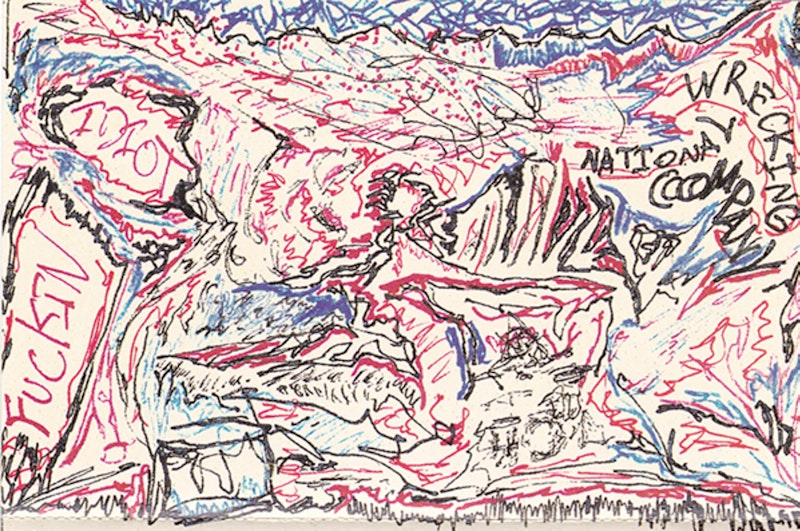I’ve worked in the performing arts for more than 30 years. It’s given me the opportunity to discover incredible artists and musicians from all over the U.S. Mostly, keeping track of these artists and their work is easy. Sometimes I befriend them. which results in long friendships where we trade each other’s records, stay in contact via email and mail, and meet up whenever we can.
Unfortunately, a handful of the artists I discovered in my travels have vanished into obscurity. Some never left a discography. Others existed for a short time and performed such esoteric work that it’s almost impossible to summarize what they achieved. And some creative heroes barely exist between fact and rumor.
This is the first in an article series which pays tribute to music acts who represent the best and most obscure of the obscure creative geniuses I’ve witnessed live.
National Wrecking Company: Some of the most pivotal incidents of my life occurred when I was 18 in the summer of 1993. One that remains burned in my consciousness is the three-day 1993 Mid-Atlantic Regional Anarchist Gathering in Philadelphia. Other than one crazy elderly radical who made a valiant attempt to turn a seminar into an orgy, most things which happened at this event were pretty dull and predictable. This includes a series of hardcore/punk concerts held concurrently to the gathering. These were booked mainly at three places: a Friends School in Center City, the west Philly punk club Stalag 13, and at the legendary Pi Lam*, a DIY music venue which was home to the University of Pennsylvania’ eponymous “freak frat.” I saw gigs at all these spaces. I don’t know how many punk/hc bands played, but after three days I’d seen a massive clutch of formulaic acts each one so similar to the next that they may as well have been the same band.
As the second night’s Pi Lam show came to a close, the final band appeared and the crowd grew small. This act was a crew of weird long hairs wearing spectacles, dirty button-down shirts, khaki shorts, and blue jeans. Barely speaking a word to anyone other than the sound engineer, they approached the “stage” (a corner of the frat house where a p.a. was set up). Unlike most other patrons there, they had no garish tattoos, no wallet chains, no spikes, no dread locks or mousse, no multi-colored hair-do’s. These scruffy nerds seemed completely out of their element, a fact that inspired annoyance and distrust from the predominantly intoxicated punk audience who probably feared these guys were gonna bust out some whiney “college rock,” or maybe even suspected them of being ”narcs.”
While they did have a loud drummer, molten fuzz guitar licks, and a rafter-rattling bassist, the group’s members played many instruments which I’d never seen at a punk show before: an electrified mandolin, an electric violin, and an electrified acoustic guitar. Their warmup sounded more like an early-1970s Grateful Dead jam than any 90s rock event. The five-piece quickly launched into their set and casually annihilated the minds of me and the five or six other people who stuck around to watch their entire performance.
The clanging tones of Appalachian music hung heavy upon the pounding rhythm section. Their arrangements were hyper-complex, ever-changing, but never improvised unless one of the players took a lengthy melodic solo. The guitar, bass, and drums roared with a chaotic attack. The other instruments howled like an old hunting dog about to croak. Even though I’d already heard (and loved) the genre mutating anti-folk music of Beck, the idea of mixing Americana with experimental prog rock was a revelation. Of all the bands I saw at the Gathering this was the only one whose political conscience manifested itself through music.
This was the sound of urban industrial collapse and rural poverty crashing in an epic musical narrative that seemed as timeless as upheaval itself. The music was about the root cause of revolutions and the mercurial nature of progress. All of this was done with barely more than few moments of vocal work in each song. For the most part the band’s approach was based around sprawling instrumental passages that revealed the symbiosis of melody, distortion, simplicity and sophistication. Not only was this the best band that played the ’93 anarchist gathering, this remains one of the greatest bands of any kind I’ve ever heard or seen live.
As their set ended the mystery crew revealed their name. “Hi everybody, we’re National Wrecking Company. That’s all we got. Thanks for stickin’ around.” I attempted to talk to one of their members: “Wow, that was amazing, great show! Do you all have any records out?” The violin player replied, ”Thanks” then nodded side-to-side saying, “No.” I asked him more questions, but was quickly shut down as the band had another gig at an afterhours spot across town where they were going to be “paid a lot more,” so they couldn’t talk and had to load out fast.
Though my memories of the 1993 Mid-Atlantic Anarchist Gathering are mainly negative, this brief respite from conformity and disappointment has stuck with me through the decades. Unfortunately, I never saw or heard anything about National Wrecking Company again until shortly before putting this story together. At some point in the early-1990s the band split up not long after they formed. NWC drummer Cheshire Augusta ended up in an early-line up of Philly cult fave Stinking Lizavetta.
National Wrecking Company's back story was predictable and has been preserved elsewhere, along with their stunning/mega rare recordings which are just as awesome as the live show I witnessed. Their origin was born of cathartic iconoclasm: a bunch of outcasts refused to toe the pop party line just to do their own thing. With or without hopeless obscurity, I feel lucky to have experienced the live power of National Wrecking Company. They proved that even when you’re surrounded by boring homogeny you can still create something beautiful.

